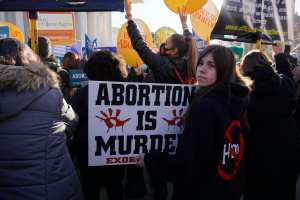Abortion and contraception equals birth dearth

The latest abysmally low birth rates from North America, Europe and Asia continue to alarm business leaders and policymakers, as well as they should.
In Europe, only France is within spitting distance of replacement-level fertility. Italy’s has tanked so low as to be the subject of a highly publicized meeting between its prime minister and the Pope a couple months ago.
Every part of North America, even Mexico, is below replacement. Asia is just as dismal or worse, with a huge majority, including all of our top trading partners — except the Philippines and (barely) India and (maybe) Vietnam — lower than replacement. Some have plummeted close to one baby per woman. When even the BBC touts headlines like “Jaw Dropping’ Crash in Babies Being Born,” and the Economist devotes an entire issue to “The Baby-Bust Economy” just last month, well, we have a problem.
Yet for decades, many of these same hand-wringing elites and policy wonks have been pushing contraception and abortion with the intensity of engineers shoveling coal into speeding trains. And not just to help married folk space, delay, or limit childbearing. No, they want every adult to be able to have sex with as many people as they want, as often as they wish, regardless of marital status, without having any babies they don’t choose.
Since at least the 1960s, separating sex from procreation has been almost an obsession. In the United States, our largest political party is radically committed to this. In recent years, climate activists, including some celebrities, have even talked as if having babies is grossly irresponsible. We have “BirthStrikers,” and “anti-natalists” who wish they’d never been born. We even have the “Voluntary Human Extinction Movement,” the subject of a recent article in The Atlantic they listed as a “must read.”
And now? The chickens have come home to roost.
Let’s look at how contraception use exploded in the 1960s, naturally leading to abortion-on-demand — these two together being the fraternal twins most responsible for our deepening Demographic Winter. We will focus on the United States, starting with contraception.
Not even counting voluntary sterilization, contraception has been around for a long time. As a PBS historical piece covered, condoms, sponges, cervical caps, diaphragms, douches, and even intrauterine devices all existed at some point in the 1800s. But they weren’t reliable, were often “messy and awkward to use,” embarrassing to obtain, and women didn’t like the fact that it was men who controlled condoms. Then along came “The Pill” in 1960. As that PBS documentary put it, “The Pill … was female-controlled, simple to use, highly effective, and … separated reproduction and contraception from the sexual act. The Pill could be taken anytime, anywhere, and without anyone else knowing.”
The pill and the sexual revolution
Most analysts of the 1960s sexual revolution have identified the widespread availability of “The Pill” as a key element and cause of this movement. But the sexual revolution would not have taken off with such intensity and speed without The Pill.
There is another key shift tied to the introduction of The Pill. According to Glenn Stanton of Focus on the Family, “the Pill made (along with corresponding legal and cultural developments) the separation between sexuality and the possibility of babies nearly an inalienable right.” (I added the emphasis.) Many people came to view being able to have sex without procreating babies as an “entitlement.”
So, we should not have been surprised that our obsession with separating sex from having babies was not sufficiently satisfied through widely available, increasingly effective, convenient, and inexpensive contraception. To fill in the gap, so to speak, we concocted another “inalienable right” — abortion. SCOTUS gave us that in 1973, in Roe v. Wade.
To be sure, many people who use contraception do not support abortion, except perhaps in rare hard cases. Embracing contraception does not equal embracing abortion.
But as Glenn Stanton also pointed out, “The fact that a woman could be sexually active and virtually guaranteed (by medical science no less!) of not becoming pregnant had the effect of making her feel cheated when an unexpected pregnancy did happen.” (Again, I added the emphasis.) For many, this meant that if a baby they didn’t want happened, well, they ought to be able to kill it before it is born. Standing in the way of any woman wishing to obtain an abortion became seen by a lot of people as fundamentally unjust, denying her “right” to have sex without having a baby.
The need for abortion
Abortion was “needed” because contraception is not foolproof, and the risk of pregnancy increases dramatically the more even “protected” sex is engaged in. Abortion was also “needed” because women and/or their partners neglecting to use contraception at all, or using it improperly, should still not, to use Obama’s infamous quote, be “punished with a baby.”
Then, abortion also became “needed” because the woman and/or her partner might not have gotten the baby they wanted or in the manner they wanted. Because the woman was pregnant: with a “defective” child, a boy but she wanted a girl, triplets but she only wanted one, and so on. The justifications for abortion rapidly expanded beyond dealing with unintended pregnancy.
Yes, there are “hard cases.” But these are an unbelievably tiny percentage of abortions. Most abortions are for women who do not want their babies.
Like contraception, abortion boomed. In 2020, the Centers for Disease Control and Prevention estimated there were 198 abortions for every 1,000 live births in the United States. At the high-water point in 1984, there were 364 abortions for every 1,000 live births, and that number never dropped below 300 for 20 years from 1976 to 1996. There were over 44,500,000 abortions between 1973 and 2015, and many more since then.
And dismal as they are, these statistics increasingly underestimate the number of abortions. Most abortions are now performed using pills, particularly mifepristone and misoprostol. When these are taken outside of clinical settings, the abortions are not included in official counts. Obtaining pills to do such “self-managed abortions” is remarkably easy. In fact, Doctors Without Borders provides instructions to help women do this. There is even a medical group in Europe that ships these pills to the United States via a pharmacy in India, intentionally and effectively circumventing laws. Such services are easily found on the Internet. Mexican pharmacies providing these pills without a prescription are also currently experiencing booming demand from Americans. At this point, the true figure is much higher than documented.
Who needs Roe?
Most liberals are in panic mode over last year’s Dobbs decision striking down Roe v. Wade. Why? With abortion pills and the ease of getting them anywhere, who needs Roe?
The story of crashing birth rates and, as most policymakers seem to acknowledge, the many serious problems these will cause, is not mostly the story of people deciding not to have sex. It is mostly because they are using a lot of contraception and abortion. Of course, there are lots of complex reasons for these two things being used as much as they are. A couple of big ones are declining marriage rates and rising age at wedlock. But one thing is sure — anyone who thinks we can continue enthusiastically pushing contraception and abortion and see birth rates increase to even marginally acceptable levels in developed countries, is a fool.
David J. Ayers is the Fellow for Marriage and Family with the Institute for Faith & Freedom. His latest book is “Christian Marriage: A Comprehensive Introduction.”




























